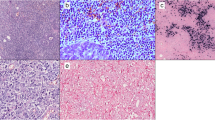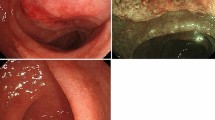Abstract
Eight secondary malignancies developing after renal transplantation were investigated in terms of a possible role of the Epstein-Barr virus (EBV). In five cases, four gastric cancers and one colonic cancer, the presence of EBV was proven by the polymerase chain reaction (PCR), all four gastric lesions being confirmed to have a massive EBV infection by in situ hydridization. Two cases demonstrated monoclonal infection with EBV, as indicated by a single band of the lymphocyte-defined membrane antigen tandem-repeat gene using PCR, and were immunohistochemically positive for the latente membrane protein 1. Our series suggests that gastrointestinal cancer predominates as a secondary malignancy in states of induced severe immunosuppression, and that EBV may play an important role in tumorigenesis as an oncovirus.
Similar content being viewed by others
Abbreviations
- PCR:
-
polymerase chain reaction
- ISH:
-
in situ hybridization
- EBV:
-
Epstein-Barr virus
- IR:
-
internal repeat
- LYOMA:
-
lymphocyte-determined membrane antigen
References
Berg LC, Copenhaver CM, Morrison VA, Gruber SA, Dunn DL, Gajl-Peczalska K, Strickler JG (1992) B-cell lymphoproliferative, disorders in solid-organ transplant patients: detection of Epstein-Barr virus by in situ hybridization. Hum Pathol 23:159–163
Coates PJ, d'Ardenne AJ, Khan G, Kangro HO, Slavin G (1991) Simplified procedures for applying the polymerase chain reaction to routinely fixed paraffin wax sections. J Clin Pathol 44:115–118
Crawford DH (1992) Epstein-Barr virus: does it cause cancer? J Trop Med Hyg 95:229–238
Goelz ZE, Hamilton SR, Vogelstein B (1985) Purification of DNA from formaldehyde fixed and paraffin embedded human tissue. Biochem Biophys Res Commun 130:118–126
Herbst H, Dallenbach F, Hummel M, Niedobitek G, Pileri S, Muller-Lantzsch N, Stein H (1991) Epstein-Barr virus latent membrane protein expression in Hodgkin- and Reed-Sternberg cells. Proc Natl Acad Sci USA 88:4766–4770
Katz BZ, Rab-Traub N, Miller G (1989) Latent and replicating forms of Epstein-Barr virus DNA in lymphomas and lymphoproliferative diseases. J Infect Dis 160:589–598
Penn I (1988) Cancer after cyclosporine therapy. Transpl Proc [Suppl 1] 20:276–279
Purtilo DT, Strobach RS, Okano M, Davis JR (1992) Biology of disease: Epstein-Barr virus-associated lymphoproliferative disorders. Lab Invest 67:5–23
Raab-Traub N, Flynn K (1986) The structure of the termini of the Epstein-Barr virus as a marker of clonal cellular proliferation. Cell 47:883–889
Rickinson A, Wallace L, Epstein MA (1980) HLA-restricted T-cell recognition of Epstein-Barr virus-infected B cells. Nature 283:865–867
Ross CW, Schlegelmilch JA, Grogan TM, Weiss LM, Schnitzer B, Hanson CA (1992) Detection of Epstein-Barr virus genome in Ki-l (CD30)-positive, Large-cell anaplastic lymphomas using the polymerase chain reaction. Am J Pathol 141:457–465
Shibata D, Tokunaga M, Uemura Y, Sato E, Tanaka S, Weiss LM (1991a) Association of Epstein-Barr virus, with undifferentiated gastric carcinomas with intense lymphoid, infiltration; lymphoepithelioma-like carcinoma. Am J Pathol 139:469–474
Shibata D, Weiss LM, Nathwani BN, Brynes RK, Levine AM (1991b) Epstein-Barr virus in benign lymph node biopsies from individuals infected with the human immunodeficiency virus is associated with concurrent or subsequent development of non-Hodgkin's lymphoma. Blood 77:1527–1533
Wright CF, Reid AH, Tsai MM, Ventre KM, Murari PJ, Frizzera G, O'Leary TJ (1991) Detection of Epstein-Barr virus sequences in Hodgkin's disease by the polymerase chain reaction. Am J Pathol 139:393–398
Author information
Authors and Affiliations
Rights and permissions
About this article
Cite this article
Suzuki, T., Takano, Y., Yamashita, K. et al. A possible role for Epstein-Barr virus in tumorigenesis after immunosuppression in cases of renal transplantation. J Cancer Res Clin Oncol 119, 627–629 (1993). https://doi.org/10.1007/BF01372727
Received:
Accepted:
Issue Date:
DOI: https://doi.org/10.1007/BF01372727




